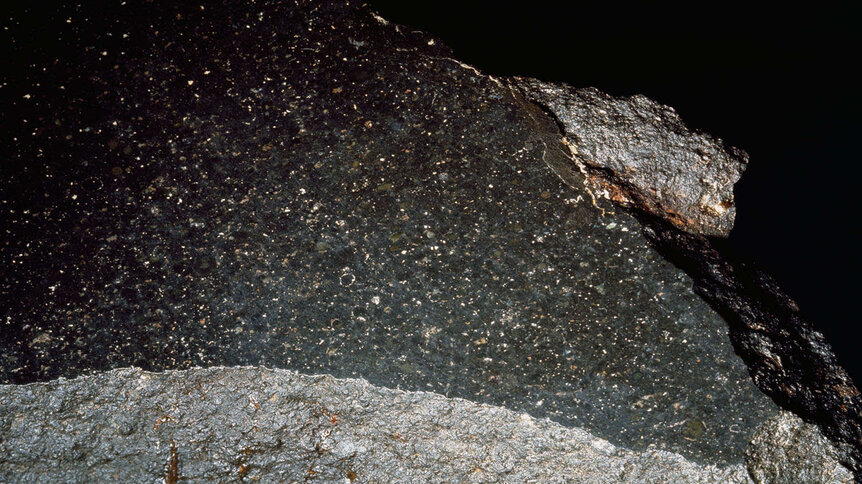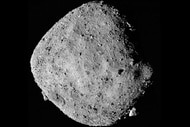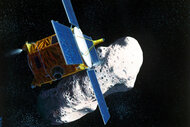Create a free profile to get unlimited access to exclusive videos, sweepstakes, and more!
Meteorite that once had CO2-rich water could mean Earth’s water came from real far out

Life as we know it needs water to survive, which may be why we tend to think of water as an Earth thing—but it’s more of an extraterrestrial thing.
Most of Earth’s water is probably alien in origin. So is the rest of the water in the solar system, since a fragment of a 4.6 billion-year-old meteorite has now been found to have once had water rich in carbon dioxide. This means that it, and at least some of our water, came from the edge of the solar system. It took the inhospitable cold of the outer solar system to freeze that CO2 into ice that eventually melted when the meteorite made it into the inner solar system, broke up in our atmosphere and landed on Earth in pieces.
Planetary scientist Akira Tsuchiyama, Visiting Research Professor at Ritsumeikan University in Japan, has finally found the sought-after meteorite water that has eluded scientists for years. There was still liquid water in calcite which was embedded in the Sutter’s Mill meteorite, which is a carbonaceous chondrite. Its chondrules, or spherical pieces of different minerals, mean it did not fully melt in the heat of early solar system formation. These types of meteorites are like cosmic time capsules.
“Most of calcite (CaCO3) grains in carbonaceous chondrite should precipitate from CO2-rich fluid,” Tsuchiyama, who led a study recently published in Science Advances, told SYFY WIRE. “Calcite is most likely precipitated from a fluid, which is responsible for aqueous alteration recorded in carbonaceous chondrites, in a parent body of the meteorite, so calcite grains should contain inclusions of such fluid.”
Even though previous studies have found signs of meteoritic fluid inclusions that had long since evaporated, an actual inclusion has never been discovered until now. Billions of years ago, the eight planets (and outlier Pluto), their moons, the Kuiper belt and everything else were not arranged in that familiar order which you probably saw in at least ten science fair projects growing up. They were scattered all over the place in the chaos of those early days. It was the immense gravitational pull of gas giants Jupiter and Saturn that arranged them as they are now and brought meteorites like the Sutter’s Mill specimen into the inner solar system.
Tsuchiyama and his team needed to use a 3D version of X-ray microscopy, known as X-ray nanotomography, to take a closer look potential inclusions in the piece of meteorite. This non-invasive method would not cause water to leak out or evaporate. What appeared to be larger inclusions must have lost their water eons ago. The problem is that nano-inclusions were too small to see at that resolution, but the scientists had a backup plan.
“We found many fluid inclusion candidates larger than a few microns in size but did not detect any fluid inside,” he said. “So we extracted a sample from nano inclusion-rich areas and observed them by a transmission electron microscope (TEM) with a higher resolution. It is not easy to detect fluid in TEM images, but we could find crystalline ice by electron diffraction at low temperature, as well as diffraction spots from ice that melted at room temperature.”
An asteroid in the young solar system would have formed as a planetesimal, the embryonic stage of a planet that or may not grow into an actual planet depending on how much material it accretes and what collisions and other phenomena it faces. Meteorites are usually pieces of those asteroids that were either unable to stick to the parent body for long enough or were knocked off by an impact from another object. Some asteroids were altered by water from melted ice, which reacted with minerals that had no water. Evidence of this has been seen in some carbonaceous chondrites.
Frozen carbon dioxide proves that the Sutter’s Mill meteorite was born in a region of the solar system cold enough for CO2 to freeze. It could have not formed beyond a certain point where CO2 ice would sublimate, or vaporize without melting first, as it does on Mars. While the water from one meteorite does not necessarily mean all of Earth’s water came from that far away, at least some of it must have been flown over from there through asteroids and meteorites that were pushed around as the solar system evolved.
“If we can find fluids with different compositions in different groups of carbonaceous chondrites, we can determine where those meteorites formed,” Tsuchiyama said. “This will give a more detailed picture of the solar system’s formation using evidence from sample analysis, which have not been obtained thus far by theoretical modeling.”
Your next glass of water could have come from the furthest reaches of the solar system billions and billions of years ago. Just try to fathom that as you drink it.















